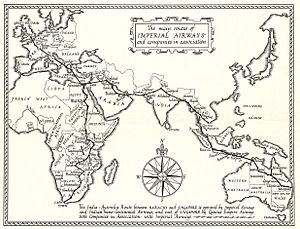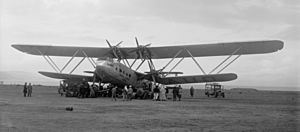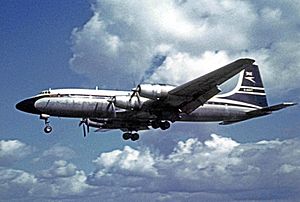Athelstan Rendall (pilot) facts for kids
Athelstan Sigfrid Mellersh Rendall (born January 3, 1914, died July 18, 2006) was a very important British pilot. His friends called him Flaps Rendall. He flew for many famous airlines like Imperial Airways and British Airways. He even became the boss pilot for the Vickers VC10 planes. During World War II, he helped Norway and was given a special award called the Order of Saint Olav. Later in his career, he shared his flying knowledge with Air Ceylon.
Contents
Early Life and First Flights
Athelstan Rendall was born in Chagford, Devon, on January 3, 1914. After going to Gresham's School, he studied at the University of Leeds. He earned a science degree in 1934. His first job was at the Herts and Essex Aero Club for two years. There, he worked on planes as a ground engineer. While working, he also learned to fly and got his pilot's licence. In 1936, he joined Imperial Airways as a pilot officer.
A Career in the Skies
His flying career started in 1936. He was a co-pilot on a biplane called the HP 42 Hannibal. He flew between Croydon Airport in London and Paris–Le Bourget Airport in Paris. After that, he joined a new route in Africa. He flew the de Havilland Express between Khartoum in Sudan and airports in West Africa.
He was a junior co-pilot, but he also did many other jobs. He was a radio operator, a flight attendant, and an engineer. He used to joke that the only real flying he did was working the plane's wing flaps. This is how he got his nickname, "Flaps." During this time, he also flew planes for the government of Colonial Nigeria. On April 1, 1940, Imperial Airways joined with another company. They formed a new airline called the British Overseas Airways Corporation (BOAC).
Flying During World War II
In the first year of World War II, Rendall flew from Lagos, Nigeria. He even flew Charles de Gaulle, a famous French general. This was part of a plan to help the Allies control French African colonies. By then, he was flying a Curtiss C-46 Commando for BOAC. He flew to places like Gibraltar, Lisbon, and the city of Malta, which was under attack. The flights to Malta were always at night because of enemy planes.
After about 18 months, he started flying the Douglas C-47 Skytrain, also known as the Dakota. BOAC had stopped flying to Stockholm because of the war. But in 1941, they started the service again. Rendall flew Dakotas at night over Denmark. He brought important Swedish ball bearings from Stockholm to Great Britain. Denmark was controlled by German forces then. Later, faster Mosquito planes replaced the Dakotas.
In the last year of the war, Rendall flew different planes. He flew Avro Yorks and Liberators to Cairo. Then he flew Lancasters to Australia. He also piloted Yorks on the route to Singapore. He was promoted to the rank of Flight Captain.
After the War and New Planes
After the war, a new plane called the Handley Page Hermes airliner came out. Rendall became the flight superintendent for BOAC's Hermes planes. He was also one of the first pilots to fly the new Bristol Britannia airliner. He became its flight superintendent too.
In 1957, he flew Queen Elizabeth the Queen Mother on a trip to the Central African Federation. He also flew Harold Macmillan, who was the British prime minister, on a tour of Africa. That same year, he became the deputy manager for the Britannia planes.
BOAC then sent him to Sydney. There, he was the flight captain for their Boeing 707 planes. In 1962, he was put in charge of the company's new Vickers VC10 fleet. This was a new British airliner. It was made to compete with American planes that flew long distances.
In 1964, Rendall praised the VC-10 in The Economist magazine. He said, "VC-10s land 20 miles per hour slower than any of the other big jets. That's good. Yet they take off the runway sooner and cruise faster." In 1965, he accepted the Cumberbatch Trophy for air safety for BOAC. Prince Philip, Duke of Edinburgh, gave him the award. In 1966, he talked about problems when new aircraft were introduced. He said that flight simulators were very helpful for training. But they were often not ready when a new plane first went on sale.
When he retired from British Airways (the new name for BOAC in 1974), Rendall had flown for 15,500 hours. He had flown 14 different types of aircraft. After retiring, he worked for Air Ceylon for three years. He advised them on their new Hawker Siddeley Trident airliners.
Personal Life
In 1938, Rendall married Marian Emma Morton. They had six children, including two sets of twins! To take them all on family trips, Rendall added an extra row of seats to his car, a Lea-Francis. He also loved sailing. He managed a large motor yacht for a friend. Later, he had his own sailboat built.
Rendall's oldest son also became a BOAC pilot. One of his granddaughters joined the Royal Air Force. She even flew a VC10 plane with No. 101 Squadron RAF. This was a plane that her father and grandfather had flown before her.
In the early 1990s, the Rendalls lived in Medstead, near Alton, Hampshire. His wife passed away in May 1990. Rendall lived for another 16 years. He died in July 2006 when he was 92 years old. All of his children were still alive.
Honours and Awards
- 1945: Knight of the Norwegian Order of Saint Olav (First Class), for his help during the war.
- 1954: Queen's Commendation for Valuable Services in the Air.
- 1955: Guild of Air Pilots and Navigators Master Pilot Certificate, for his long service and great achievements.
- 1959: Liveryman of the Guild of Air Pilots and Navigators.
- January 1, 1964: Officer of the Order of the British Empire (OBE).
See Also
- List of people educated at Gresham's School





